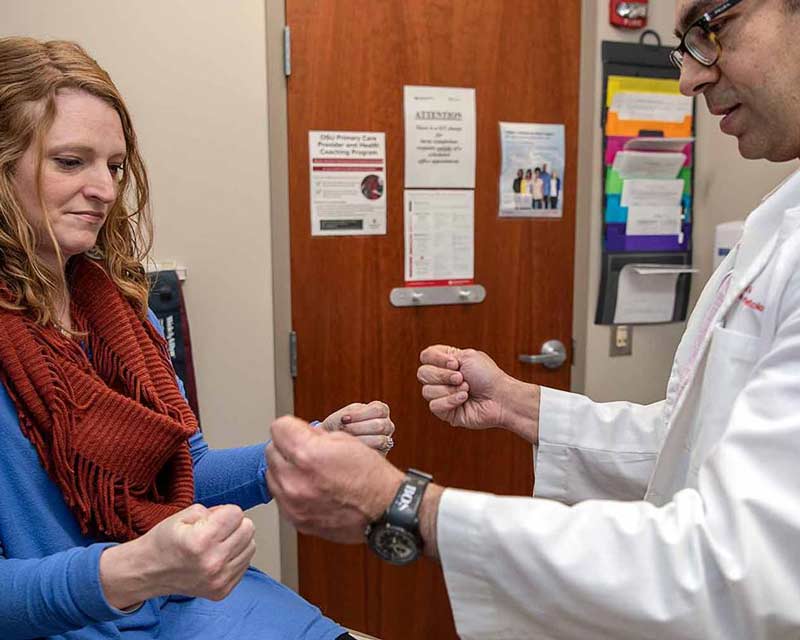
Researchers combine nanobiotechnology, neutrophils and nucleic acid to combat lupus
 Doctors find cardiovascular inflammation occurs independent of renal disease
Doctors find cardiovascular inflammation occurs independent of renal diseaseA study from researchers at The Ohio State University Wexner Medical Center explore some of the reasons why patients with lupus are at higher risk for cardiovascular disease.
Rheumatologist Stacy Ardoin, MD, professor of Pediatrics in the Department of Internal Medicine’s Division of Rheumatology and Immunology at the Ohio State College of Medicine and chief of Pediatric Rheumatology at Nationwide Children’s Hospital, teamed up with Wael Jarjour, MD, professor and director of the Division of Rheumatology and Immunology, to determine why many of her patients present with a high level of myocardial inflammation – despite not showing clinical symptoms.
“We think that this chronic inflammation of the heart may be how these patients develop non-atherosclerotic heart failure – and why they are at increased risk for cardiovascular morbidity and mortality,” Ardoin says.
This type of non-atherosclerotic, directly inflammatory cardiovascular disease is characterized as myocarditis and can significantly increase mortality in patients with lupus.
The traditional risk factors for cardiovascular disease, such as high blood pressure and high cholesterol, don’t explain why young people with lupus end up with such severe cardiovascular disease, Jarjour says.
Jarjour designed a study, with input from Ardoin, to more closely explore other nontraditional risk factors that patients with lupus might possess that result in cardiovascular disease.
“One thing we wanted to focus on is looking for an independent process that could explain the increased cardiovascular risk in lupus that ties to an inflammatory disease process,” Jarjour says.
Epidemiological data show that patients with systemic lupus erythematosus experience:
Only a small number of patients with lupus (between 5% and 10%) are diagnosed with myocarditis. Yet autopsy studies show evidence of myocarditis in up to 40% of patients.
As patients with lupus live longer lives, they’re at risk of developing cardiovascular disease. This study opens the door to the potential need for more closely monitoring lupus patients for atherosclerotic and non-atherosclerotic cardiovascular disease.
Lupus nephritis is a common complication for patients with lupus. Kidney involvement is also well recognized as a risk for cardiovascular disease in lupus. This study, using a mouse model, shows that myocarditis may potentially be a risk factor for young patients independent of kidney disease.
The mouse hearts were evaluated regularly using magnetic resonance imaging (MRI) and echocardiography. Their blood was tested for inflammatory indicators, specifically cytokines and chemokines.
At the end of the study, the mouse hearts and kidneys were examined. The histological studies showed myocarditis without significant evidence of renal disease.
“This suggests that targeting of the cardiovascular system is independent of kidney pathology and can take a different trajectory,” Jarjour says.
While these data come from mice, they do need to be validated in humans. The mouse study supports the primary pathological role of autoimmune-mediated, cardiac-targeted inflammation in lupus.
Jarjour’s study results open the door to more research to help further understand lupus in humans. Benefits of the investigation include a viable mouse model for future lupus research and a model for studying potential therapeutics related to myocarditis and lupus.
“We now know that the heart may be uniquely involved in lupus and ultimately that could be important if we decide that this causes problems long-term,” Ardoin says.
Ardoin and Jarjour say longer-term studies are needed to better understand the impact of this heart inflammation on patients with lupus.
“We’re not at the point yet where we’re saying we need to do cardiac MRIs for every lupus patient, but we need to be considering a lower threshold for checking for myocarditis in our patients,” Ardoin says.
In the future, Jarjour will look specifically at what factors these lupus mice have that make the myocardium a target for the autoinflammatory process.
The histologic findings in the mice did suggest that there may be potential targets for treatment.
“Especially in the T cells, and that bears more investigation in human and mouse models so we can determine the most effective treatments,” Ardoin says.
The mouse models will play a key role in this ongoing challenge, as it’s difficult to biopsy a living human heart. To understand all the mechanisms at play in lupus-related myocarditis, research will rely on biomarkers.